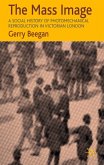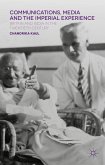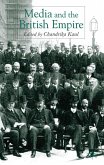The Mass Image situates the creation of the first photographically illustrated magazines within the social relations of the emerging popular culture of late Victorian London. It demonstrates how photomechanical reproduction allowed the illustrated press to envisage modern life on a much more intense scale than ever before.
'In additon to being an important work on photomechanical reproduction in its own right...The Mass Image is also a fascinating and valuable read for any and all scholars of pre-cinema and early cinema in general.' - Simon Brown, Journal of British Cinema and Television
'Beegan offers a scrupulous historical account of one aspect of an otherwise well-documented visual culture. The technical and biographical information exhibited here ensures that this will be a valuable resource for anyone with an interest in the photographically reproduced image. A number of Beegan's conclusions are refreshingly counterintuitive in disrupting the triumphant march toward ever greater realism presumed to follow the introduction of the photograph. The common Victorian failure to recognize 'the act of representation within reproduction', as Beegan points out, mirrors our own continued failure to do so.' - Matthew Rubery, Victorian Studies
'By bringing us into the Victorian social history and cultural debates surrounding the development of new techniques of mechanical reproduction, Beegan takes us beyond Walter Benjamin's over-used pronouncements on 'aura' and into the complex relationships among aesthetics, technologies, labor, and meaning. As with many late twentieth- and early twenty-first-century works on the Victorian period, Beegan emphasizes the continuities with our own visually saturated world and with technological innovations that seem to mirror and exacerbate theever more fragmented experience of urban modernity.' - Amy Woodson-Boulton,Visual Resources
'Beegan's highly knowledgeable discussion of nineteenth-century graphic arts, design and reproduction technology frequently proves crucial to the insights arising from this informative study. ... It is not only the author's incorporation of his extensive historical knowledge but also his sensitivity to the multiple influences on the history of visual images in Victorian periodicals that makes Beegan's book a necessary read and a delight for any scholar interested in Victorian popular culture.' - Dennis Denisoff, Victorian Review
'This is an excellent, in-depth yet broad-ranging study of the way changes in illustration and image reproduction affected the production of mass-media journals in London and environs over the nineteenth century. Though Beegan focuses on illustration in the 1890s, he also ranges widely across issues related to technology, print culture and readership. In doing so he breaks genuinely new ground while complementing existing work on photography, illustrated magazines and technological innovation in the nineteenth century.' - William Baker, The Year's Work in English Studies
'Taking as his starting point the key insight that 'new illustrated magazines both produced and reflected the visibility that was central to modernity, Gerry Beegan here offers a detailed account of late Victorian London based periodicals and their illustration. In bringing together a study of photo-reprographic modes, techniques and potentialities with detailed analysis of how illustration constructed self-perceptions among the readers of illustrated journalism, Beegan has written an extremely well informed, conceptually sophisticated and pioneering study of the late Victorian press. Complex yet accessible, his book will be essential reading for all those interested in the cultural politics of the image, and further demonstration of the insights that book history brings to our understanding of the past.' - Dr. Brian Maidment, Research Professor in Print History, University of Salford, UK
'An experienced graphic designer, Gerry Beegan combines practical knowledge with theoretical insight and astute cultural analysis in this groundbreaking social history of the mass image in 1890s London. In an engaging style grounded in lucidly described technical particulars and thoroughly researched historical examples, Beegan demonstrates the essential hybridity of process engraving as a mixture of hand and machine technologies and maps the emergence of modern graphic design in the development of halftone illustration. This study will be a necessary resource for students and scholars studying modernity, the popular press, and the image in the age of photomechanical reproduction.' - Lorraine Janzen Kooistra, Professor and Chair, Department of English, Ryerson University, Toronto
'What this fascinating book achieves, and one reason why it is such a valuable addition to the literature, is a successful synthesis of detailed technical information with sophisticated cultural analysis.' - Fiona Hackney, University College Falmouth, Journal of Design History
'Beegan offers a scrupulous historical account of one aspect of an otherwise well-documented visual culture. The technical and biographical information exhibited here ensures that this will be a valuable resource for anyone with an interest in the photographically reproduced image. A number of Beegan's conclusions are refreshingly counterintuitive in disrupting the triumphant march toward ever greater realism presumed to follow the introduction of the photograph. The common Victorian failure to recognize 'the act of representation within reproduction', as Beegan points out, mirrors our own continued failure to do so.' - Matthew Rubery, Victorian Studies
'By bringing us into the Victorian social history and cultural debates surrounding the development of new techniques of mechanical reproduction, Beegan takes us beyond Walter Benjamin's over-used pronouncements on 'aura' and into the complex relationships among aesthetics, technologies, labor, and meaning. As with many late twentieth- and early twenty-first-century works on the Victorian period, Beegan emphasizes the continuities with our own visually saturated world and with technological innovations that seem to mirror and exacerbate theever more fragmented experience of urban modernity.' - Amy Woodson-Boulton,Visual Resources
'Beegan's highly knowledgeable discussion of nineteenth-century graphic arts, design and reproduction technology frequently proves crucial to the insights arising from this informative study. ... It is not only the author's incorporation of his extensive historical knowledge but also his sensitivity to the multiple influences on the history of visual images in Victorian periodicals that makes Beegan's book a necessary read and a delight for any scholar interested in Victorian popular culture.' - Dennis Denisoff, Victorian Review
'This is an excellent, in-depth yet broad-ranging study of the way changes in illustration and image reproduction affected the production of mass-media journals in London and environs over the nineteenth century. Though Beegan focuses on illustration in the 1890s, he also ranges widely across issues related to technology, print culture and readership. In doing so he breaks genuinely new ground while complementing existing work on photography, illustrated magazines and technological innovation in the nineteenth century.' - William Baker, The Year's Work in English Studies
'Taking as his starting point the key insight that 'new illustrated magazines both produced and reflected the visibility that was central to modernity, Gerry Beegan here offers a detailed account of late Victorian London based periodicals and their illustration. In bringing together a study of photo-reprographic modes, techniques and potentialities with detailed analysis of how illustration constructed self-perceptions among the readers of illustrated journalism, Beegan has written an extremely well informed, conceptually sophisticated and pioneering study of the late Victorian press. Complex yet accessible, his book will be essential reading for all those interested in the cultural politics of the image, and further demonstration of the insights that book history brings to our understanding of the past.' - Dr. Brian Maidment, Research Professor in Print History, University of Salford, UK
'An experienced graphic designer, Gerry Beegan combines practical knowledge with theoretical insight and astute cultural analysis in this groundbreaking social history of the mass image in 1890s London. In an engaging style grounded in lucidly described technical particulars and thoroughly researched historical examples, Beegan demonstrates the essential hybridity of process engraving as a mixture of hand and machine technologies and maps the emergence of modern graphic design in the development of halftone illustration. This study will be a necessary resource for students and scholars studying modernity, the popular press, and the image in the age of photomechanical reproduction.' - Lorraine Janzen Kooistra, Professor and Chair, Department of English, Ryerson University, Toronto
'What this fascinating book achieves, and one reason why it is such a valuable addition to the literature, is a successful synthesis of detailed technical information with sophisticated cultural analysis.' - Fiona Hackney, University College Falmouth, Journal of Design History








